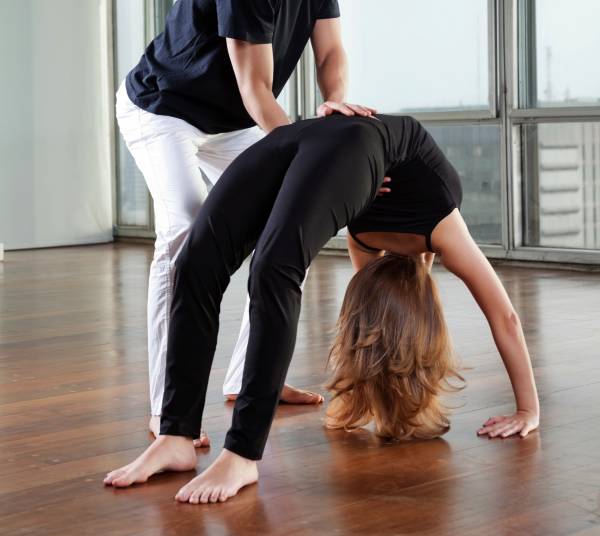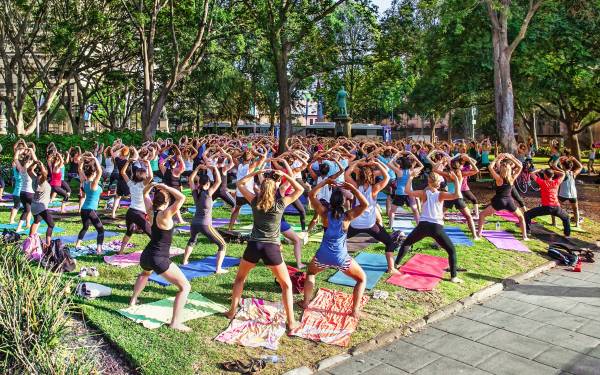About a month into my marriage, my husband and I took a yoga class together with a fairly well known and respected teacher. Halfway into the class, the teacher, who was male, straddled over me in bridge pose and lifted my hips.
This created an amazing opening in my shoulders and I let out a sound – a sound my husband later described to me as a moan. This, along with other sexual innuendos the instructor made throughout the class, made us both uncomfortable.
About a month into my marriage, my husband and I took a yoga class together with a fairly well known and respected teacher. Halfway into the class, the teacher, who was male, straddled over me in bridge pose and lifted my hips.
This created an amazing opening in my shoulders and I let out a sound – a sound my husband later described to me as a moan. This, along with other sexual innuendos the instructor made throughout the class, made us both uncomfortable.
This is just one example of how the line between appropriate and inappropriate contact can become blurred in a yoga class. But this incident became the catalyst for me to examine my responsibilities as both a student and a teacher.
It’s important for teachers and students to take action when something doesn’t feel right.
When Hands-On Adjustments Go Bad
I’ve had other experiences that were subtler. Where I felt like maybe someone’s adjustment was a little on the sexual side. But when this happens, I always brush it off and assume I’m just reading it the wrong way. Our tendency is to give the benefit of the doubt and to think, “Oh, it’s not a big deal.” But the high-profile cases of yoga celebrities such as Bikram Choudhury and John Friend serve as stark examples of where this kind of misuse of sexual energy can lead.
“Let’s face it: the sexual energy that’s at play everywhere gets magnified in most yoga classes. A room full of sweaty bodies, tight and possibly revealing clothes, bodies moving sensually, deep breathing.”
And while men are often the perpetrators and women the victims, it also happens the other way around. A close friend shared with me how a popular female teacher had blatantly and repeatedly made sexual advances toward her husband during a yoga retreat they were on together.
As a teacher, hands-on adjustments are important to me in helping my students find and transform unconscious patterns in their bodies. Sometimes a touch is the only thing that can bring the needed awareness. When used responsibly, hands-on adjustments are an important teaching tool, so I’m not saying teachers shouldn’t use them. But there needs to be an awareness on both sides in knowing when a line has been crossed.
The Power of Sexuality
Let’s face it: the sexual energy that’s at play everywhere gets magnified in most yoga classes. A room full of sweaty bodies, tight and possibly revealing clothes, bodies moving sensually, deep breathing. A yoga class can be a great place to meet like-minded people and potential love interests. That’s a beautiful thing among peers. But student-to-student interactions fall into a different category than teacher-student ones.
“When used responsibly, hands-on adjustments are an important teaching tool, so I’m not saying teachers shouldn’t use them. But there needs to be an awareness on both sides in knowing when a line has been crossed.”
Sexuality is a powerful force, and it can be used constructively or destructively. In addition to the cases mentioned earlier, many popular teachers have reputations tainted with scandal for dating their students. Yoga teachers literally hold people’s hearts in the palms of their hands, and students automatically assume they can trust someone in that role of teacher. Most of us come to yoga because we want to open up, let go, and heal. This makes us vulnerable. For an instructor to take advantage of that vulnerability may not be a legal offense in most cases, but I think it’s definitely a moral one.

Hands-on adjustments are an important teaching tool, but students and instructors need to be aware of boundaries.
Steps to Take
When it comes to misuse of sexual power, the yoga community is operating like a dysfunctional family that’s pretending the problem doesn’t exist. No one wants to talk about it. But yoga can only transform as a culture in as much as those within it transform as individuals. So it’s important for teachers and students to become aware and be willing to take action when something doesn’t feel right.
“One of the best steps you can take if you’re facing a situation like this is to talk to someone you trust. Often, just voicing your concerns will bring you clarity.”
This can be difficult when your teacher is popular and you see everyone viewing him or her in such a positive light. You may doubt yourself, as I have, and think, “Maybe I’m just making this up? Maybe I’m projecting my own stuff onto them?”
It’s true, we often do project our own stuff onto teachers and therapists – but not always. One of the best steps you can take if you’re facing a situation like this is to talk to someone you trust. Often, just voicing your concerns will bring you clarity. You might also take some classes with different teachers and compare. If you find the same feelings coming up with many different teachers, then maybe it is your issue.
But if you do determine that your concerns are grounded, then you have some choices to make:
- You can simply stop studying with that particular teacher and stay quiet.
- You can talk directly to the teacher about your concerns.
- If the teacher isn’t the studio owner, you can talk to the studio manager or owner.
- If the instructor is registered with one of the governing bodies (such as Yoga Alliance or IAYT), you could also report the misconduct to them.

Sweaty bodies, bodies moving sensually, deep breathing – sexual energy is magnified in many yoga class settings.
If This Speaks to You, Speak Up
Having the courage to bring this topic out into the open will facilitate transformation, not only for the individuals involved, but also for the yoga community as a whole. Speaking up will inspire others to do the same. You can bet if it’s happening to you, then it’s happening to others. Remember, the yoga community is 80% women and they are the primary victims of abuse.
We should also all remember that yoga teachers are human. They bring their own wounds into the practice just as their students do, so don’t put them on a pedestal. Respect is one thing, but worship is another. A good yoga teacher knows he or she is just the conduit, not the focal point.
You’ll Also Enjoy:
- 8 Perspectives on Gender in the Gym
- Women and Group Exercise: Theories From a Male Instructor
- Is Your Yoga Practice Keeping You From Finding Your Soulmate?
- New on Breaking Muscle Today
Photos courtesy of Shutterstock.






